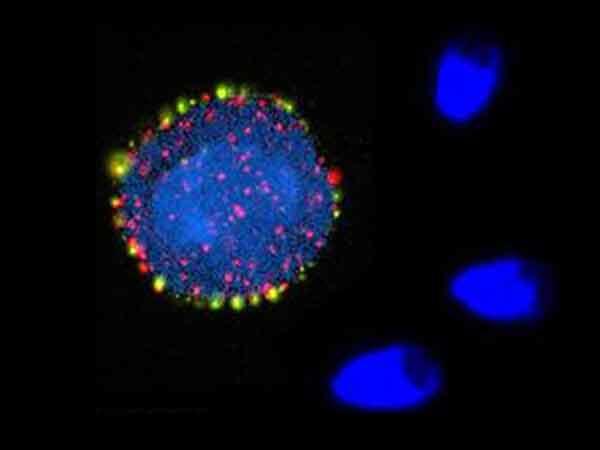Study Identifies Crucial Characteristic of High-Risk HPV
, by NCI Staff
NCI researchers have found that for the most common high-risk type of human papillomavirus (HPV) to cause cervical cancer, an important viral gene may need to have a precise DNA sequence. The findings, the researchers believe, contribute to a better understanding of HPV biology and may have implications for cervical cancer prevention and treatment.
The study investigators analyzed the genomes of HPV type 16—one of the most potent human carcinogens—from more than 5,000 infected women around the world, making it the largest genomic study of HPV16 to date. Some of the women in the study had cervical cancer while others did not.
They found that the sequence of a viral oncogene called E7 was almost identical among women with cervical cancer but had many different mutations among those without cancer.
“We knew that E7 was important, but we didn’t realize that its genetic conservation might be critical for HPV16 to cause cancer,” said lead investigator Lisa Mirabello, Ph.D., of NCI’s Division of Cancer Epidemiology and Genetics (DCEG). “Conservation” refers to whether the sequence of a gene remains unchanged over time.
The new findings were reported online on September 7 in Cell.
“This study really nicely shows that E7 is a very important, arguably the most important, oncogene for HPV16-associated cervical cancer development,” said Dohun Pyeon, Ph.D., associate professor of immunology and microbiology at the University of Colorado, who was not involved in the study.
Genetic Alterations in HPV16
Persistent infection with one of a dozen high-risk HPV types can lead to cervical, anal, oropharyngeal, and other cancers. HPV16, however, is the cause of half of all cervical cancers and an even larger fraction of other HPV-related cancers.
Although it is estimated that roughly 40% of women will be infected with a high-risk type of HPV at some point in their lives, most of these infections are successfully controlled by the immune system. Scientists do not fully understand why only some HPV infections persist and lead to cervical precancer or cancer.
Dr. Mirabello and her colleagues obtained cell or tissue samples from about 3,960 HPV16-infected women in the United States or Costa Rica who had benign infections, advanced cervical precancer, or cancer. Advanced cervical precancer (also called CIN 3) can turn into cancer, and in the United States, it is treated to prevent progression to cancer.
They found a high amount of diversity between the HPV16 genomes of all the samples; only about a quarter of the HPV16 genomes were exactly the same between two or more women in the study. When they looked at the quantity of mutations, they found that the HPV16 genomes from women with benign infections had more mutations than those from women who had precancer or cancer.
Both E6 and E7 are viral oncogenes that are thought to be responsible for cancer development in HPV16-infected women. The researchers found a similar amount of mutations in E6 among the women with cancer or precancer and the women with benign infections.
However, they found far fewer mutations in E7 among women who had precancer or cancer compared with women who had benign infections. In fact, for women who had precancer or cancer, E7 had the fewest mutations compared with any other gene in the HPV16 genome.
The researchers found similar patterns when they analyzed HPV16 genomes from more than 1,600 cervical cancer samples obtained from women in 39 different countries.
The team’s findings strongly suggest that “the uniquely potent” cancer-causing ability of HPV16 “hinges on the E7 protein remaining in its exact form,” said the study’s senior author, Mark Schiffman, M.D., also of DCEG, in a Cell press release.
Next, the researchers investigated how mutations in E7 may arise. They turned to a family of enzymes in human cells, called APOBEC3, which fight infections by introducing mutations into viral DNA. If unrepaired, these mutations could potentially impair the virus’s ability to survive in human cells. Several studies have shown that APOBEC3 enzymes may help cells resist HPV16 infection.
APOBEC3 enzymes tends to introduce mutations within a specific short DNA sequence. Dr. Mirabello and her colleagues found that, in the HPV16 genomes from women with benign infections, mutations in E7 often appeared in this APOBEC3-associated DNA sequence. This raises the possibility that mutations in E7 may be caused by an APOBEC3 enzyme, they wrote.
Understanding the Role of E7 in Cervical Cancer
The researchers are now taking a closer look at the mutations that may be induced by APOBEC3. By comparing these mutations across the viral genomes of women with and without cancer or precancer, their goal is “to try and understand which mutations are having a negative effect on the carcinogenic potential of the virus,” Dr. Mirabello said.
Identifying a genetic biomarker (such as a specific mutation) “that could suggest which HPV16 infections are likely to progress to cancer would be of tremendous clinical benefit,” Elizabeth White, Ph.D., of the University of Pennsylvania, and Karl Munger, Ph.D., of Tufts University wrote in an accompanying commentary. It might, for example, help identify HPV16-infected women who should have more frequent cervical cancer screenings.
Exactly how E7 mutations may reduce the cancer-causing potential of HPV16 is also unknown. A better understanding could come from an analysis of the effects of E7 mutations on proteins in human cervical cells, said Dr. Pyeon.
“The E7 protein binds to dozens, possibly hundreds, of proteins in human cells,” he explained. For example, E7 binds to and prompts degradation of pRB, a human protein that plays a major role in controlling cell growth. Genetic mutations could potentially disrupt or enhance E7’s binding to these target proteins.
